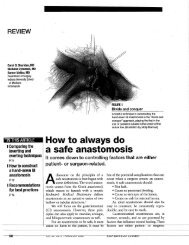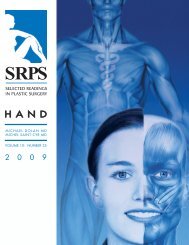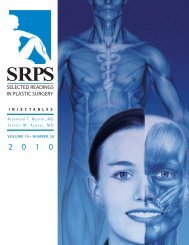Craniofacial Anomalies, Part 2 - Plastic Surgery Internal
Craniofacial Anomalies, Part 2 - Plastic Surgery Internal
Craniofacial Anomalies, Part 2 - Plastic Surgery Internal
Create successful ePaper yourself
Turn your PDF publications into a flip-book with our unique Google optimized e-Paper software.
inconvenience to the patient and the cutaneous scars.<br />
The intraoral device was more socially acceptable<br />
and left no visible scars, but there was loss of vector<br />
control and a second procedure was required to<br />
remove the device.<br />
Polley 484 reported on an external halo-mounted<br />
device for midfacial monobloc DO in a newborn.<br />
Chin and Toth 464 and Cohen 486 developed internal<br />
devices for midface advancement (Fig 30), citing<br />
the advantage of patient convenience;<br />
Cohen’s 486,487 device was resorbable to eliminate<br />
the need for a removal procedure. Motor-driven<br />
distraction devices have also been reported. 488<br />
External devices are most commonly used in the<br />
midface. 489<br />
Fig 30. Patient with repaired cleft lip and severe midfacial<br />
hypoplasia. A, B, before distraction. Middle, patient fitted with<br />
rigid external distraction apparatus for correction of midfacial<br />
deficiency. C, D, after maxillary distraction. (Reprinted with<br />
permission from Polley JW, Figueroa AA, Kidd M: Priciples of<br />
Distraction Osteogenesis in <strong>Craniofacial</strong> <strong>Surgery</strong>. In: Lin KY,<br />
Ogle RC, Jane JA (eds), <strong>Craniofacial</strong> <strong>Surgery</strong>. Science and<br />
Surgical Technique. Philadelphia, WB Saunders, 2002; Ch 11,<br />
pp 163-171.)<br />
<strong>Craniofacial</strong> Distraction<br />
SRPS Volume 10, Number 17, <strong>Part</strong> 2<br />
Mandible<br />
McCarthy’s protocol for mandibular distraction is<br />
based on patient age and type of mandibular deformity,<br />
as follows: 461<br />
Under 2 years – DO of the mandible is not indicated<br />
Age 2-6 years –<br />
Pruzansky Type I – orthognathic surgery including<br />
DO are deferred until adolescence490,491 Pruzansky Type I (severe) and Type II –<br />
DO is indicated<br />
Pruzansky Type III – Stage I: costochondral rib<br />
graft at age 3-4 yrs; if absent, the glenoid is<br />
reconstructed with a rib graft and fixed to<br />
the zygoma. Stage II: DO of the rib graft at<br />
6 months postinsertion of costochondral rib<br />
graft<br />
Age 6-teenager – primary DO is considered if no<br />
previous treatment. Secondary DO is<br />
considered in patients with significant deformity<br />
after rib grafting.<br />
Teenager – surgery is postponed until skeletal maturity<br />
is reached.<br />
Post skeletal maturation – minimal deformities are<br />
best treated with classic orthognathic surgery. 492<br />
Mandibular distraction should be considered in<br />
patients with moderate to severe deformity and<br />
bilateral disease. 493<br />
McCormick and colleagues 494,495 investigated the<br />
effect of osteodistraction on the temporomandibular<br />
joint (TMJ), first in a canine model and then in human<br />
subjects. Compression on the cartilaginous portion<br />
of the condylar head has been shown to be detrimental<br />
to subsequent TMJ morphology and function,<br />
496–498 yet in this series initial condylar flattening<br />
was transient and completely reversible. In fact, bone<br />
distraction appears to improve the temporomandibular<br />
joint. 499 When properly applied, the distraction<br />
forces pull the mandible in a downward and forward<br />
direction, leading to new bone deposition along<br />
the posterior aspect of the mandible and resorption<br />
along the anterior ramus region. 500 The overall conclusion<br />
of these studies was that distraction was beneficial<br />
to the TMJ complex.<br />
Speech before and after mandibular DO was<br />
assessed by Guyette et al, 501 who report worse<br />
articulation and nasal resonance post-distraction.<br />
These changes were temporary, however, and in<br />
45






